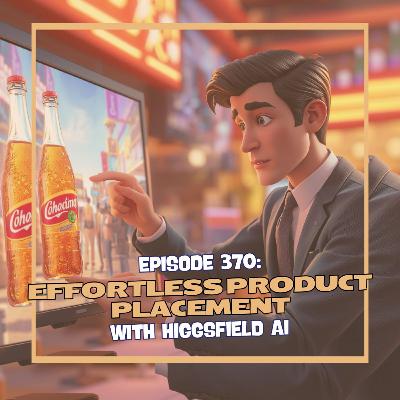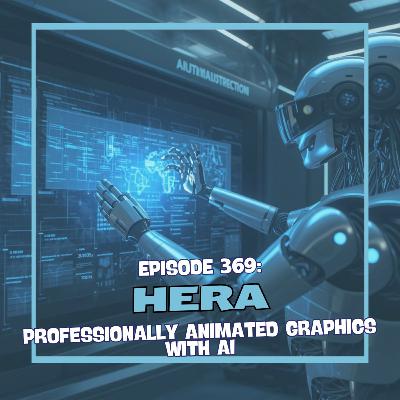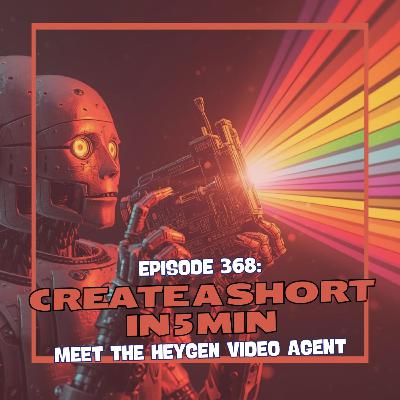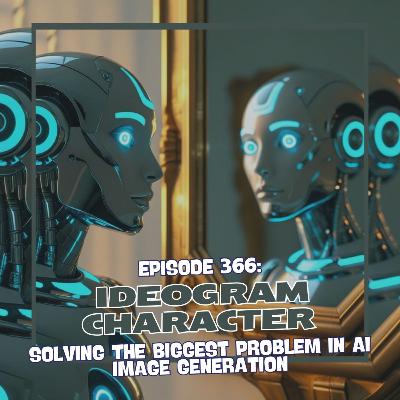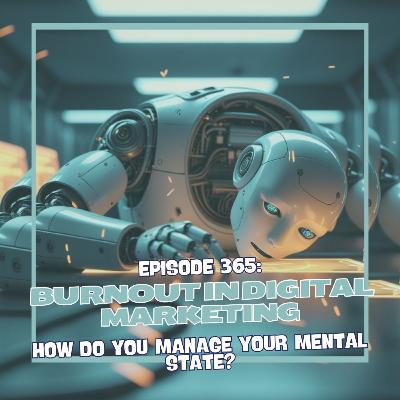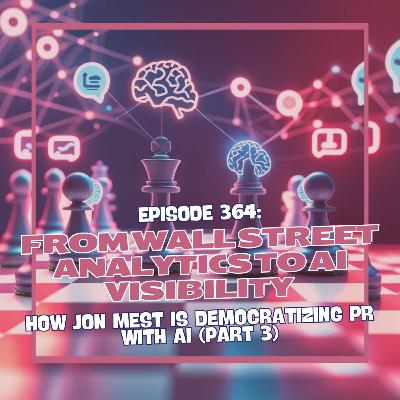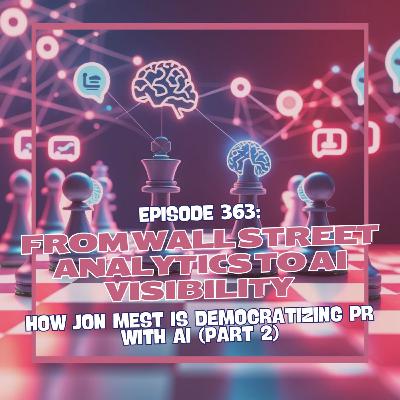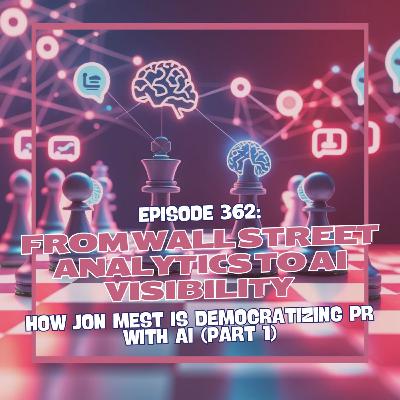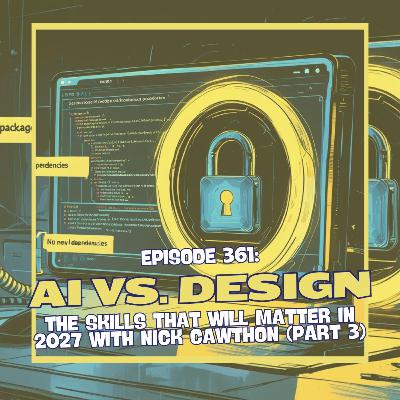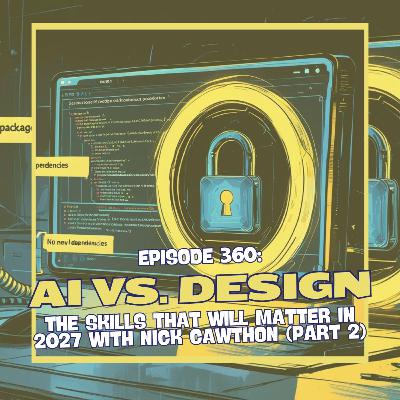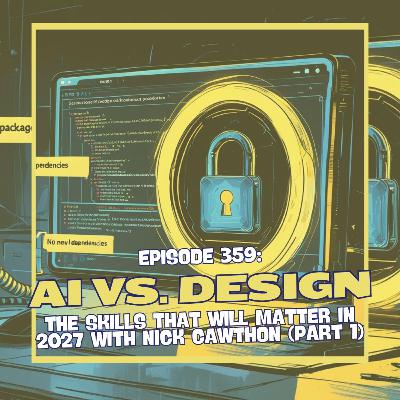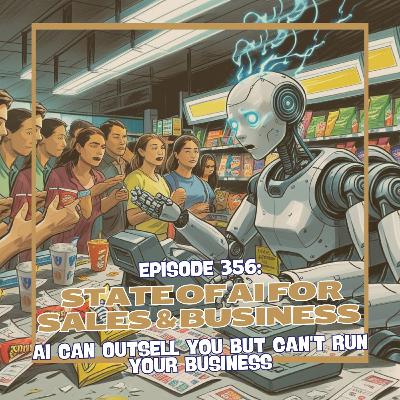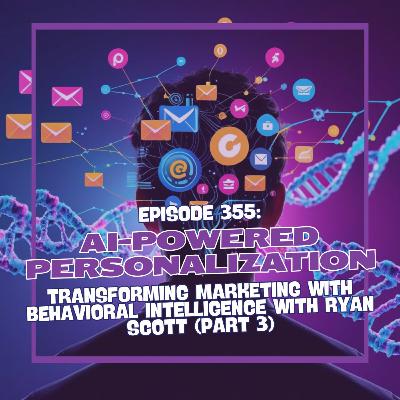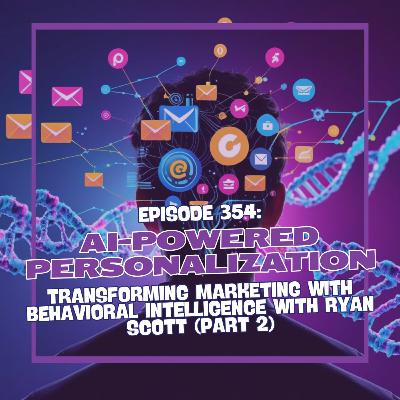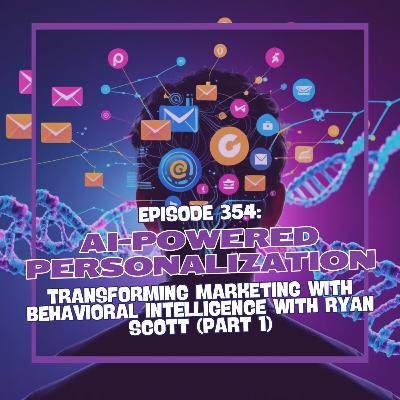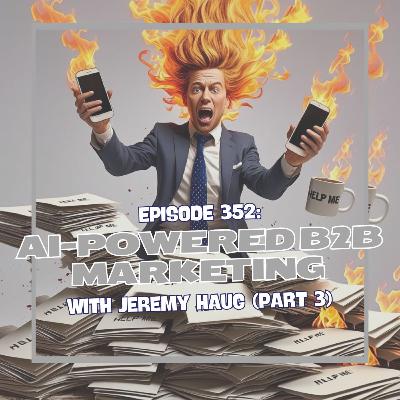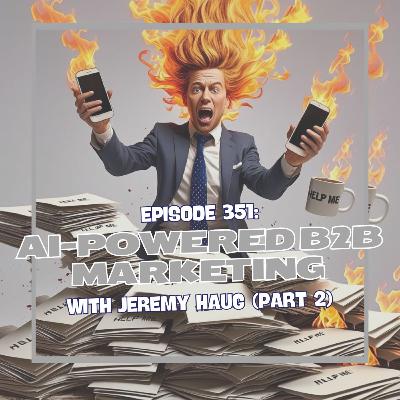Discover The AI Marketing Navigator
The AI Marketing Navigator

The AI Marketing Navigator
Author: Alex Carlson
Subscribed: 12Played: 106Subscribe
Share
© Alex Carlson
Description
Dive into the world of digital marketing as it intersects with the cutting-edge advancements in artificial intelligence with "The AI Marketing Navigator." This podcast is your compass in the evolving landscape of AI-enhanced marketing, offering you daily insights, strategies, and actionable tips. With fingers on the pulse of the latest on AI in: SEO, content marketing, social media, email marketing, and more, get the updates and tactics you need to navigate the complexities of marketing in the AI age. Subscribe to "The AI Marketing Navigator" to transform the way you think about marketing.
371 Episodes
Reverse
AI Marketing Navigator Show Notes: Higgsfield AI Creative HubIn this episode, we explore Higgsfield AI, a comprehensive creative platform that has evolved far beyond traditional AI image and video generation into a complete creative hub for marketers. Host Alex Carlson demonstrates how Higgsfield's pre-packaged "apps" and "effects" turn viral video concepts into ready-to-use marketing assets, featuring advanced product placement capabilities through tools like "Banana Placement" that allow precise control over where products appear in generated content.KeywordsHiggsfield AICreative Hub PlatformAI Video EffectsProduct Placement TechnologyViral Video TemplatesMarketing Asset CreationAI-Powered AdvertisingVisual Effects GenerationBrand Marketing AutomationSocial Media ContentProduct Marketing VideosAI Creative ToolsBanana Placement Tool3D Product RenderingASMR Marketing ContentKey TakeawaysCore FunctionalityFunctions as complete creative hub beyond basic AI image/video generationPre-packages viral video effects and concepts into ready-to-use "apps"Offers extensive library of visual effects and templated marketing conceptsFeatures advanced product placement through drawing/masking toolsSupports both image and video output formats for maximum flexibilityIntegrates multiple AI models and generation engines in single platformProvides intuitive scrolling interface for discovering effects and templatesEnables rapid iteration and testing of different creative conceptsIncludes specialized tools like Renaissance portraits, 3D renders, and ASMR contentOffers horror face effects and dramatic visual transformations for scroll-stopping contentBusiness ApplicationsCreates high-quality product advertising videos in minutes vs. weeksGenerates B-roll footage for social media and paid advertising campaignsProduces graffiti-style ads and urban marketing contentDevelops 3D product renders and action figure transformationsCreates ASMR marketing content for sensory-driven campaignsGenerates Renaissance-style portraits with realistic crowd reactionsProduces dramatic burning scenes and intense visual effects for impactEnables rapid A/B testing of different creative approaches and stylesFacilitates product placement in existing scenes and environmentsStreamlines creation of viral-worthy content for organic social reachIntegration CapabilitiesWorks seamlessly with existing marketing workflows and asset librariesSupports product image uploads for precise placement and integrationCompatible with various social media platforms and advertising formatsEnables batch creation through templated approaches and saved effectsFacilitates collaboration through shared creative assets and templatesIntegrates with broader AI marketing toolchain including Nano BananaSupports export to multiple formats for cross-platform distributionEnables custom product integration through drawing and masking toolsProvides API potential for enterprise creative automation workflowsConnects with social media publishing and campaign management platformsMarket PositioningPositioned as creative operating system rather than simple generation toolTargets solo marketers and small agencies competing with corporate resourcesDifferentiates through pre-packaged viral concepts and marketing templatesFocuses on democratizing high-end creative capabilities for small businessesCompetes with expensive production teams and professional video servicesEmphasizes speed and accessibility while maintaining professional quality standardsAddresses gap between AI tools and actually usable marketing contentRepresents significant advancement toward "Super Bowl ad" quality democratizationEnables creative parity between solo marketers and large agency teamsPositions as essential tool for modern paid media and social advertising strategiesLinkshttps://higgsfield.ai/
In this episode, we explore Hera AI, a powerful AI motion designer tool that creates animated graphics and text from simple text prompts. Building on the previous episode's discussion of HeyGen's Video Agent, host Alex Carlson demonstrates how Hera AI can fill the remaining gap in AI video production by generating high-quality B-roll footage, animated graphics, and supplementary visual elements that complement AI-generated avatar content to achieve truly publishable video results.KeywordsHera AI Motion DesignerAI Animation ToolAnimated Graphics GenerationText Animation CreationB-Roll Video ContentMotion Design AutomationVideo Graphics ProductionAI-Powered AnimationMarketing Video EnhancementSocial Media AnimationEnd Screen CreationDynamic Text EditingBrand Style IntegrationTemplate-Based AnimationVideo Content AugmentationKey TakeawaysCore FunctionalityCreates animated graphics and text from simple text promptsOffers multiple aspect ratios (widescreen, vertical, square, portrait)Supports videos up to 60 seconds in length by defaultProvides real-time editing capabilities with cursor-based element manipulationIncludes dynamic chat-based editing for style and content modificationsFeatures brand style integration with custom and default optionsSupports reference image and video imports for style guidanceEnables custom font and audio imports for personalized contentHandles CSV data integration for animated charts and graphsIncludes "ensure good design" feature with preview capabilitiesBusiness ApplicationsCreates end screen call-to-actions for podcast and video contentGenerates animated social media graphics and advertisementsProduces B-roll footage to complement AI avatar videosDesigns animated infographics and data visualizationsCreates branded intro and outro sequences for video contentDevelops animated banners and promotional graphicsProduces Instagram reels and short-form social contentGenerates animated logos and brand identity elementsCreates presentation graphics and animated slide contentDevelops marketing campaign visual assets at scaleIntegration CapabilitiesWorks well manually with HeyGen Video Agent to complete video production workflowIntegrates custom brand styles and color schemesSupports template creation and reuse for consistent brandingCompatible with various video editing platforms through export optionsEnables collaborative editing through shared template librariesFacilitates batch creation through template-based approachesProvides history tracking for easy access to previous creationsSupports transparent background exports for compositing workflowsIntegrates with social media posting workflowsEnables API-based automation for enterprise content productionMarket PositioningPositioned as complement to AI video generation tools like HeyGen and SoraTargets content creators, marketers, and small business ownersBridges gap between AI-generated content and professional video productionOffers free tier access with premium features for advanced usersCompetes with traditional motion graphics tools like After EffectsFocuses on speed and accessibility over complex professional featuresEmphasizes template-driven approach for consistent brand applicationDifferentiates through AI-powered prompt-to-animation workflowAddresses specific need for high-quality B-roll and supplementary contentRepresents final piece in complete AI video production pipelineLinkshttps://hera.video/
In this episode, we explore HeyGen's revolutionary Video Agent, a comprehensive AI-powered creative operating system that generates complete publishable videos from single prompts. Host Alex Carlson demonstrates this groundbreaking tool through live testing and iterative improvements, showing how it addresses the gap between existing AI video generators and truly usable marketing content by handling script creation, casting, visuals, voice, pacing, captions, and editing in one intelligent workflow.KeywordsHeyGen Video AgentAI Video GenerationAvatar CreationMarketing Video AutomationCreative Operating SystemEnd-to-End Video ProductionAI ScriptwritingCustom Avatar IntegrationVideo Marketing ToolsAutomated Content CreationB2B Video ContentEducational Video CreationSocial Media Video ProductionAI Voice CloningKey TakeawaysCore FunctionalityGenerates complete publishable videos from single text promptsHandles script creation, casting, visuals, voice, pacing, captions and editing automaticallyIntegrates custom avatar creation and voice cloning capabilitiesSupports multiple video orientations (portrait/landscape) and lengthsIncludes B-roll footage integration and visual data representationsProcesses videos through intelligent workflow entirely in browserOffers iterative editing capabilities through studio interfaceMaintains consistency across scenes while allowing granular customizationSupports both animated and live-action avatar stylesIncludes community submission gallery for inspiration and templatesBusiness ApplicationsCreates newsletter subscription promotional videos in minutesGenerates educational content for social media (reels, shorts)Produces marketing explainer videos with custom brandingDevelops product demonstration videos at scaleCreates personalized sales outreach videos with custom avatarsStreamlines video content creation for non-video professionalsEnables rapid A/B testing of video marketing conceptsReduces dependency on expensive video production teamsFacilitates consistent brand messaging across video campaignsAccelerates time-to-market for video marketing initiativesIntegration CapabilitiesWorks seamlessly with custom avatar creation workflowsIntegrates 11Labs voice cloning technology for personalized audioSupports multiple video export formats and resolutionsCompatible with existing HeyGen avatar and voice librariesEnables bulk video creation through template-based approachesProvides API access for enterprise workflow integrationSupports collaborative editing through studio interfaceFacilitates content repurposing across multiple platformsIncludes automated captioning and accessibility featuresStreamlines distribution to social media and marketing channelsMarket PositioningFirst truly comprehensive end-to-end video agent for marketingPositioned as creative operating system rather than simple generatorTargets marketers, content creators, and small business ownersDifferentiates from text-to-video tools like Sora through complete workflowCurrently in beta with community-driven feature developmentAddresses gap between AI video clips and production-ready contentCompetes with traditional video production workflows and agenciesEmphasizes speed and accessibility over Hollywood-level production qualityFocuses on 60-80% production quality threshold for publishable contentRepresents significant advancement in democratizing video creation technologyLinkshttps://heygen.com
In this episode, we explore Google's revolutionary "Nano Banana" AI image editor (officially Gemini 2.5/Image), a cutting-edge natural language image editing tool that's transforming how marketers create visual content. Host Alex Carlson demonstrates live how this free tool can replace weeks of expensive Photoshop work with simple 30-second voice commands, showing real-time edits to personal headshots and product marketing materials.KeywordsNano BananaGoogle Gemini Image EditorAI Image EditingNatural Language ProcessingMarketing AutomationVisual Content CreationAdvertising VariationsProduct MarketingDesign DemocratizationReal-time Image GenerationMarketing PersonalizationA/B Testing VisualsCreative Asset ProductionSocial Media ContentBrand Asset VariationsKey TakeawaysCore FunctionalityEdits images through simple natural language commandsMaintains original image artifacts while making precise changesProcesses edits in real-time (approximately 30 seconds per change)Remembers previous edits for iterative modificationsGenerates new images from text descriptionsRenders text directly onto images with embroidered effectsBlends and remixes multiple images into cohesive stylesTransfers styles, textures, and patterns between imagesIncludes SynthID watermarking for AI-generated content identificationWorks seamlessly within Google Gemini interface via banana iconBusiness ApplicationsCreates hundreds of advertising variations without design costsEnables rapid A/B testing of visual elements across campaignsPersonalizes creative assets for different audience segmentsGenerates product mockups and prototypes instantlyProduces social media content variations at scaleFacilitates virtual try-ons for e-commerce applicationsStreamlines creative workflows for non-designersReduces dependency on expensive graphic design resourcesAccelerates time-to-market for visual marketing campaignsDemocratizes professional design capabilities across organizationsIntegration CapabilitiesAccessible through Google Gemini web platform and mobile appAvailable in Google AI Studio for developersAPI access at $30 per million output tokens (~1,290 tokens per image)Compatible with existing Google Workspace ecosystemsSupports bulk processing workflows (future capability expected)Integrates with marketing automation platforms via APIEnables seamless content creation within existing workflowsProvides developer tools for custom application integrationSupports enterprise-scale content generation requirementsFacilitates cross-platform content distribution strategiesMarket PositioningFree access through Google Gemini platformPositioned as industry leader in consistency and speedOutperforms ChatGPT image editing in processing timeCurrently supports English language prompts onlyTargets marketers, small businesses, and content creatorsCompetes directly with Adobe Photoshop for basic editing tasksEmphasizes accessibility and ease-of-use over advanced featuresFocuses on democratizing design capabilities for non-technical usersAddresses growing demand for personalized marketing contentRepresents significant shift toward AI-powered creative workflowsLinkshttps://gemini.google.com/
In this episode, we explore Ideogram AI's revolutionary character consistency feature that solves the long-standing problem of maintaining visual identity across multiple AI-generated images, with hands-on demonstration and practical applications.KeywordsIdeogram AI, Character Consistency, AI Image Generation, Visual Branding, Content Creation, Character Feature, AI Marketing Tools, Creative Workflows, Brand Mascots, YouTube ThumbnailsThe Core Problem SolvedTraditional AI image generators couldn't maintain character consistency across multiple imagesFace changes, hair differences, core identity vanishing between generationsLimited creators from developing serialized, branded contentPrevious solutions required complex model retraining and technical expertiseIdeogram's Breakthrough ApproachOne reference image, infinite variations - core principleUpload single high-quality photo (clear, well-lit, front/three-quarter view)Advanced algorithm analyzes and locks in distinctive traitsNo model retraining or complex fine-tuning requiredCharacter traits lock in after one uploadTechnical SophisticationGoes beyond pixel pattern memorizationUnderstands facial structure, hair characteristics, core identity elementsMaintains character integrity across different lighting, expressions, contextsSophisticated analysis enables dramatic style variations while preserving identityAdvanced Creative FeaturesMasking Option: Precise adjustments to hair, clothing, accessories, facial detailsBatch Generation: Multiple variations simultaneously with character integrityMagic Fill: Insert characters into any context while preserving identityRemix Tool: Style transfer and scene adjustments with identity preservationRemix Weight Parameter: Control balance between consistency and creative flexibilityPractical ApplicationsBrand ManagementConsistent mascots across marketing materials without expensive photo shootsVirtual influencer development accessible to smaller brandsCohesive brand storytelling across multiple touchpointsContent CreationYouTube thumbnail creation with recurring charactersCharacter-based storytelling series for individual creatorsSocial media content with consistent visual brandingE-commerce & GamingConsistent character assets for virtual goodsGamified experiences with reliable character representationEnhanced UX and brand recognition across digital platformsLive Demonstration ResultsUsed podcast thumbnail screenshot as reference imageGenerated character "scuba diving in underwater ruins"Impressive character consistency across four variationsGood photorealism with proper lighting integrationSpeed of generation notably fastWorkflow AccessibilityProfessional creators can leverage advanced masking and remixingCasual users achieve impressive results through simple prompt descriptionsScalability across skill levels for broad adoptionIntegration with web, API, and iOS platformsTools fit existing workflows rather than requiring adaptationsPricing StructureFreemium: 10 free character generations for trialBasic: $8/month (monthly billing)Plus: $20/monthPro: $60/monthFree trials remove adoption barriersSubscription tiers for advanced features and professional useCompetitive AdvantagesNo extra training required vs. traditional solutionsUser-friendly design with immediate functionalitySingle image approach removes technical barriersBroad platform support including mobile devicesAccessible during inspiration moments, not just formal productionFuture ImplicationsAI systems understanding persistence and consistency like human creative thinkingMovement toward AI as creative collaborator vs. simple generation toolPrinciples could apply to brand consistency, architectural elements, product designAI platforms evolving toward comprehensive creative suitesLinkshttps://ideogram.ai/https://www.perplexity.ai/search/ideogram-meU.wTKzRCaDKSmdaF8wQg
In this deeply personal episode, Alex opens up about experiencing burnout as a solo entrepreneur in digital marketing and AI, sharing the three core areas he's identified as contributing factors and asking for community input on overcoming these challenges.KeywordsEntrepreneur Burnout, Digital Marketing Burnout, Solo Entrepreneur Challenges, Work Life Balance, Financial Stress, Time Management, Lifestyle Management, Small Business Mental Health, Freelancer Burnout, Personal Burnout RecoveryKey TakeawaysEpisode ContextLongest break yet between podcast recordings due to host burnoutPersonal recharge time spent in northern Michigan on the lakeHonest admission that this isn't the first time experiencing burnoutDecision to share raw, personal aspects despite potential brand riskThe Core Question"How do other solo entrepreneurs or solo freelancers, leaders of small teams combat the burnout that comes with the incredible pace and nature of the shifting landscape that is digital marketing and now AI marketing?"Recognition that personal aspects contribute equally to burnout as professional aspectsSeeking community conversation and solidarity rather than providing solutionsThree Core Burnout Pillars1. Time Management / Work-Life BalanceChallenge of compartmentalizing priorities: family first, work second, personal wellbeing thirdDifficulty balancing family time with business growth demandsStrict scheduling approach: set morning self-care time, defined work hours, sacred family time (5-8pm)Late night work dilemma: 9pm-midnight or later to grow businessKey question: "Are these hours actually required, or is this workload leading to burnout?"2. Financial Management and Money StressAdmission of struggling with money management throughout adult lifeFinancial anxiety contributing to mental fatigue and burnoutNeed for deliberate spending decisions for both business and personal expensesImportance of realistic long-term income/expense projectionsCommitment to sticking to budgets despite difficulty3. Lifestyle ManagementManaging personal vices that creep into daily lifeExamples: end-of-day cocktails, snack breaks, other comfort habitsVices becoming "finish lines" instead of long-term goalsNeed to prioritize family future, business security over immediate gratificationRecognition that boring but important things must take precedenceTime Management SolutionsWell-organized, well-structured daily calendarTrue commitment to routine and disciplineRoutine leading to more personal freedom long-termCompartmentalization of priorities without overlapMultiple job juggling challenges (9-5 plus freelancing)The Sacrifice vs. Burnout DilemmaBelief that envisioned success requires sacrifice and long hoursQuestion whether late-night work is necessary or harmfulExploration of optimizing other life areas to compensateRecognition that both professional and personal aspects contribute equallyCommunity Engagement RequestExplicit ask for listener feedback and conversationInterest in hearing others' burnout experiences and solutionsRequest for time management and financial management strategiesDesire for input on tackling vices and negative lifestyle cyclesPersonal VulnerabilityAdmission of being "almost too proud to say" but sharing anywayRecognition that many others struggle with similar issuesEmphasis on solidarity and community supportBreaking down stigma around entrepreneur mental healthRoutine as Freedom PhilosophyDiscipline and routine leading to more personal freedomStructure providing clarity rather than restrictionImportance of consistency in daily patternsBalance between rigidity and flexibilityThe Reality CheckBurnout in solo entrepreneurship isn't just about work overload - it's a complex intersection of time management, financial stress, and lifestyle choices that require honest self-assessment and community support to address effectively.
In this episode, we explore the crucial balance between AI automation and human relationships in PR, revealing why the most successful campaigns combine technological efficiency with authentic human connection.KeywordsAI vs Human PR, Relationship Building, Journalist Outreach, PR Automation, Human Touch Marketing, Content Creation Strategy, Digital Platform Authority, MLB Stadium Quest, Just Reach Out Philosophy, Authentic PRKey TakeawaysThe AI Spam ProblemEveryone can immediately spot AI-generated outreach in LinkedIn and emailJournalists receive 10x more obvious AI spam than regular usersAI-written pitches get caught in spam filters and deleted instantlyHuman oversight prevents embarrassing automated mistakesAI as Assistant, Not ReplacementAI excels at finding relevant journalists and building media listsAI provides narrative feedback and pitch structure guidanceAI catches spam filter words and optimizes email lengthHumans must still craft, edit, and send personalized messagesThe Relationship Dividend"I can't tell you how often this happens" - journalists respond months laterInitial "not writing this story right now" becomes "actually writing about this topic"Connecting journalists with other experts builds long-term relationship capitalBeing top-of-mind matters more than immediate coveragePlatform Authority Building StrategyLinkedIn posts: Write authoritative content, expect zero likes initially but put it out thereReddit: Find relevant subreddits, contribute authentically to conversationsMedium: Start writing, even with one reader - consistency builds authorityAI models scrape YouTube comments, Yelp reviews, TripAdvisor, G2 reviewsThe "Just Do It" PhilosophyMost people get overwhelmed and never start creating contentCustomer example: Had perfect pitch drafted but needed Zoom call to click "send"One strong blog post can increase visibility from 0% to 70% overnightStart with one post, then two, then three - build momentum graduallyHuman Verification FutureNext 2-3 years: Distinguishing human vs AI content becomes criticalPeople getting "duped" by AI artists on Spotify without realizing itAI models detect and penalize AI-generated content clustersEarned media from humans will always carry more weightROI Measurement TacticsAdd "AI models" option to "How did you hear about us?" formsTrack UTM codes from ChatGPT and other AI platformsFocus on revenue maintenance/growth, not just traffic metricsOffer consulting projects to prove LEO effectiveness to skeptical executivesThe 10 vs 1000 Email Rule10 highly personalized, researched pitches outperform 1000 automated blastsHuman research and customization beats mass automation every timeAI reduces time investment from 20 hours to 1-2 hours weeklyQuality targeting with AI assistance delivers better results than quantity spamBaseball Stadium AchievementJon visited all 30 MLB stadiums (record now incomplete due to new Atlanta/Texas stadiums)Cross-country road trip knocked out 14 stadiums in one monthData science background fueled love of baseball statisticsPersonal goals matter alongside professional achievementsThe Reality CheckTraditional PR agencies have relationship access that tools can't replicate, but you can build those relationships yourself through consistent value delivery and authentic human connection over time.Key InsightThe future belongs to those who use AI to become more efficient humans, not to replace human judgment. The most successful PR combines AI research and optimization with genuine relationship building and authentic storytelling.This episode demonstrates that while AI can dramatically improve PR efficiency, the core of successful public relations remains fundamentally human: building trust, providing value, and maintaining authentic relationships with journalists and audiences.Linkshttps://justreachout.io/https://chatrank.ai/
In this episode, we explore how Jon Mest's team transformed a devastating Google AI overview crisis into a breakthrough business opportunity, creating ChatRank and revolutionizing AI-powered visibility strategies.KeywordsGoogle AI Overviews, ChatRank, LEO Optimization, Just Reach Out Acquisition, AI Visibility Crisis, Search Algorithm Changes, Business Acquisition Strategy, AI Marketing Tools, Authority-Based Ranking, Meritocratic SEOKey TakeawaysThe $4 Google CrisisGoogle spending dropped from thousands monthly to exactly $4 in three weeksAI overviews buried their #1 ranking content and ads overnightTeam initially thought system was broken until discovering massive AI overview placementCrisis occurred August 2024, affecting core search terms completelySmart Acquisition PhilosophyAcquired Just Reach Out in 2021 using "good product, good customers, improvable business" thesisChose scaling existing business (1-to-10) over building from zero (0-to-1)Added AI automation and self-serve capabilities to democratize PRMaintained founder Dmitri's strong SEO foundation while expanding reachCrisis-to-Opportunity PivotEngineering team reverse-engineered AI overview ranking factorsBuilt internal tools that became ChatRank.ai (launched December 2024)Now receiving weekly referrals from ChatGPT, Perplexity, and ClaudeSpun ChatRank into separate subscription business complementing Just Reach OutAI Ranking RevolutionOver 50% of Google AI overview results come from non-page-one contentPage 7 content can outrank page 1 if it provides the best answerAuthority matters more than backlinks in AI model rankingsAI models fact-check content against all available sourcesNew Ranking FactorsAuthority over Links: AI seeks most authoritative content, not most backlinksMeritocratic System: Best answer wins regardless of traditional SEO metricsTruth Requirements: AI models quickly identify and penalize false informationAnswer Engine Focus: Tools like ChatGPT prioritize single best answer, not link collectionsStrategic Business LessonsDon't panic during algorithm changes - reverse engineer and adaptCrisis often reveals new business opportunitiesAI democratizes visibility for smaller players with better contentComplementary tools create stronger ecosystem (ChatRank + Just Reach Out)ChatRank DifferentiationSeparate subscription at ChatRank.aiOptimizes for ChatGPT, Google AI Overviews, Perplexity, ClaudeFocuses on content quality and authoritative positioningComplements traditional PR outreach with AI visibility strategyThe Reality CheckTraditional SEO's link-based authority system is being replaced by AI's merit-based content evaluation. Companies with the best answers can now compete with industry giants, regardless of backlink budgets.Key InsightThe shift from attention economy to authority economy means AI models reward genuine expertise over SEO manipulation. Small businesses can now achieve visibility previously reserved for large corporations with massive link-building budgets.This episode demonstrates that algorithmic disruptions, while initially devastating, often create opportunities for innovative companies willing to adapt quickly and build solutions for the new landscape.Linkshttps://justreachout.io/https://chatrank.ai/
In this episode, we explore the bootstrap mindset revolutionizing entrepreneurship through Jon Mest's journey from Wall Street M&A to democratizing PR with AI-powered tools.KeywordsBootstrap Entrepreneurship, Wall Street to Startup, PR Democratization, Just Reach Out, ChatRank, LEO Optimization, Narrative Building, VC vs Bootstrap, AI-Powered PR, Sustainable GrowthKey TakeawaysThe $30,000 PR Wake-Up CallWall Street veteran paid $30,000 to NYC PR agency, got zero resultsCrystallized philosophy: "I only exist tomorrow because I sold a client today"Founders tell their stories better than agenciesApplied banking due diligence to all business decisionsBootstrap Success Formula1010 Data: 13 years bootstrapping to $500M exitCore mindset: spend money like it's your own because it isBuild what customers ask for, not impressive pitch deck featuresEvery dollar must be justified and worthwhilePR Strategy RevolutionWrong approach: "I'm amazing, write about me"Right approach: understand journalist's audience, work backwardsNarrative building sessions identify multiple story anglesMatch stories to outlets (Forbes vs technical publications)AI Democratization ImpactJust Reach Out serves 5,000+ customers worldwideChatRank launched December 2024 for LEO optimizationTargets ChatGPT, Google AI Overviews, Perplexity visibilityMakes professional PR accessible without $30K agency feesVC vs Bootstrap PhilosophyBest time to raise VC: when you don't need itVC money creates 100x return pressure, not sustainable growthBootstrap forces real business model validation firstFreedom from LP pressure enables customer-focused decisionsApplied Mathematics ApproachEngineering discipline focused on analytical problem-solvingWall Street M&A at Thomas Weisel PartnersData science background plus human communication skillsAnalytical rigor disrupts relationship-driven industriesStrategic ImplicationsValidate business before seeking external fundingApply analytical thinking to traditional relationship businessesFocus spending on customer-requested solutionsBuild sustainable growth over investor-pleasing metricsThe Reality CheckBootstrap mindset creates businesses building real value for real customers rather than impressive investor metrics. Combined with AI democratization, small businesses access professional capabilities previously reserved for enterprises.Key InsightAnalytical problem-solving skills transfer across industries. Sustainable growth comes from constraint-driven innovation, not unlimited capital. AI is democratizing professional services while the bootstrap philosophy ensures customer-first focus.Links:https://justreachout.io/https://chatrank.ai/
In this episode, we explore the voice-first future of technology and how AI enables instant expertise building, featuring Nick Cawthon's insights on family tech adoption, RAG systems for learning, and preparing for the diamond-shaped workforce.KeywordsVoice Interface Design, RAG Systems, Universal Basic Income Research, Diamond-Shaped Workforce, AI Learning, Human Computer Interaction, Future of Work, Sandwich Generation Technology, Knowledge Graph Building, Strategic ThinkingKey TakeawaysThe Voice-First GenerationNick's 83-year-old mother and preteen kids both learned technology through voice commandsFirst computer interaction: "Hey Google, turn on the projector" - no keyboards or screensVoice assistants became entry point for both aging eyes/unsteady fingers and young mindsWhisper dictation tool mission: "kill the keyboard" - physical interaction decreasingAR/VR Reality CheckNick deliberately missed the AR wave - headsets and goggles never appealed to himVoice interface seemed better approach than "strap-on technologies"Still gun-shy about Google Glass and Oculus failuresVoice accessibility wins over visual complexity for multi-generational usersBuilding AI Teachers: The UBI ProjectPhilanthropist hired Nick to visualize Universal Basic Income data - topic he knew nothing aboutTraditional approach: weeks in academic libraries with highlightersAI approach: Built custom RAG (Retrieval Augmented Generation) system with 200 articlesCreated knowledge graph trained to speak in philanthropist's voiceGenerated academic-level citations with traceable referencesRAG System BenefitsFast expertise building: "talk about UBI at a party" within days instead of monthsNo hallucination risks - all answers traceable to source materialCustom voice training for client communication styleNarrative generation to accompany data visualizationsThe Agency Learning Pattern"You are like an improv actor every couple months where you've got a new thing you gotta know something about"Next month it might be banking, hybrid milk, or any random topicProcess: train a model to understand pros/cons and aggregate diverse sourcesResult: well-rounded opinions and starter directions for any subjectFuture of Work PhilosophyWork will never completely disappear - "connection between mind and body will always need to take place"Nick's 13-year-old son: paid Dungeon Master at neighborhood school"You're being paid to think with your mind... tell a story to a captive audience"Future work: strategic thinking, adaptability, human connectionThe Career Choice FrameworkFriend's 10-year-old quote: "Either you're gonna pick a career where you tell computers what to do, or computers tell you what to do"Quote "kept me up at night" - drives staying ahead of technologyImportance of being on the right side of that equationAutonomy and levity about industry changesDiamond-Shaped WorkforceShift from pyramid-shaped to diamond-shaped workforce"Very few at the top, very few at the bottom, everybody else in the middle"Optimistic view: "Instead of climbing corporate ladder, you've been given a jetpack"Can "go right to the top" with velocity never seen beforeHistorical ParallelsEarly 2000s: Dreamweaver and visual web design tools democratized business creationAnyone could have website and business behind itSimilar empowerment happening now with LLM training and AI toolsFocus on empowering thoughts vs. "oh shit, I'm gonna get downsized"San Mateo County ModelGovernment efforts to ensure AI tools don't replace jobs but create new onesFocus on interpreting what new job types are opening upImportant distinction: transformation vs. eliminationEveryone will play a part in this changeLinkshttps://retrain.gauge.io/
In this episode, we explore the seismic shift from SEO to LLM optimization with Nick Cawthon, revealing how designers and marketers must adapt to a world where AI agents browse websites and clients find businesses through ChatGPT.KeywordsLLM Optimization, AI Design Education, Human-in-Loop Design, Screenless Future, Rabbit Device, San Mateo County AI Policy, Design Curriculum Revolution, Strategic Thinking, Pattern Libraries, Agent-Based BrowsingKey TakeawaysThe New SEO: LLM Optimization"We just got our first client who said they found us on ChatGPT. How did we do that? And nobody knows."Same muscle memory moment as 20-25 years ago when internet went mainstreamRush to optimize for LLMs parallels early 2000s SEO scrambleAlgorithm unknown, results delivery method changing fundamentallyAI Research RevolutionDescript's auto-transcription was early AI adoption for content creatorsSan Mateo County requires human-in-loop pledge for AI tool usageCannot use auto-transcription/translation for 5 official county languagesWorkers upskilled from repetitive tasks to AI workflow managementDesign Education TransformationNick rewrote entire California College of Arts curriculum due to AI velocity"If the back half of design timeline is moving at such speed, it puts importance on front half strategic thought"AI accelerates bad ideas just as fast as good onesFocus shifted from tool mastery to strategic thinkingCritical Skills for AI EraEvidence-based research and strategy over technical executionUnderstanding market conditions and user contextStrategic thinking before jumping into prototypes"If you took away those tools, how are you still a designer?"The Vulnerability AssessmentNick launching industry survey at retrain.gauge.ioProduct and engineering teams using same design tools"We are all very vulnerable here" - need to prove unique valueUnderstanding process/procedure for user testing remains designer strengthScreenless Future ImplicationsRabbit device (by Teenage Engineering) browses websites for usersAI agents understand pattern libraries and click buttons autonomouslyQuestion: "Who are we designing for? Are we designing for agents now?"Visual will always have place, but interaction patterns changingHuman-in-Loop as Competitive AdvantageMaking things intentionally messy at points to show authenticityTransparency about "here's how we're doing this" while maintaining efficiencyBringing humanistic elements into algorithmic workflowsProving human oversight in increasingly automated worldThe Content Strategy RealityCurrent podcast conversations seed transcription algorithmsKeywords from Spotify scrapes will match future searches"What you're doing right now is excellent" - content creation as LLM optimizationQuality storytelling with balanced content beats gaming algorithmsHistorical ParallelsDesktop-first to mobile-first transition (Luke Wroblewski era)Platform wars created billion-dollar opportunities (Google AdWords)Technology sweeps rug out from comfortable patternsMust reexamine marketing presence, campaigns, content, interfacesThe Fortune 100 Reality CheckEven highly regarded financial services technology adapters lag behind"If they're a couple steps behind, what about rest of corporate America?"Unsung heroes: designers maintaining patterns in large organizationsSmall user groups (12 users, 3 teams) handling millions in deal workflowsStrategic vs Technical FocusQuality of story being told now matters more than publishing mechanicsTechnical marketing tasks (social media, websites, paid ads) becoming automatedStrategic concept quality determines success or failure accelerationMid-career professionals returning to school for AI reassessmentLinkshttp://retrain.gauge.io/
In this episode, we explore enterprise AI design with Nick Cawthon, founder of Gauge Design, who reveals why flashy AI design demos fail in real-world enterprise environments and shares his revolutionary approach to bridging the design-development gap.KeywordsEnterprise AI Design, Cursor AI, Human Computer Interaction, Design Operations, Component Libraries, GitHub Integration, Gauge Design, UX Consultancy, Pattern Libraries, Frontend Development, Design SystemsKey TakeawaysThe Enterprise Design Reality CheckBeautiful Figma deliverables often get "dropped on the floor, run over by a tractor, and picked apart by vultures"Development teams lack capability, priority, or resources to implement complex designsJunior developers struggle to interpret design components without experienceSix-month consultant timelines don't allow for traditional design approval workflowsThe Cursor AI Enterprise ApproachClone client's GitHub repo instead of starting with FigmaTrain Cursor AI on existing component libraries and Storybook patternsLock React version 1.14 and specific Tailwind versionsPrevent new dependencies - no changes to package.json filesUse organization's actual design patterns as AI training materialsEnterprise Guardrails StrategyAI stops and asks before creating new componentsMust organize within existing variable systemsCan't bring in outside libraries like Shad CNAll prototypes connected to Google Sheets databasesHandles workflows worth hundreds of millions in partner dealsThe Human-in-Loop ModelAllocated 20% of contract budget to frontend engineer10 hours weekly to catch mistakes and guide AI implementation"Stand shoulder to shoulder with somebody who understands the technology better"Cursor resolves merge conflicts and version control issuesEssential for enterprise environments with real financial consequencesDesign-to-Development Gap SolutionStart at the finish line with actual codebaseReduce traditional gap between design and development teamsWork within existing constraints rather than creating new onesJunior designer learned new workflow instead of showcasing Figma skillsPrototypes use real data transformation through 11-step processesLinkedIn Demo vs Enterprise Reality"Zero to one" demos are impressive but not enterprise-readyMost designers work with existing pattern libraries and constraintsText-to-design algorithms focus on "brochureware" not internal toolsEnterprise requires intricate components, not off-the-shelf librariesReal enterprise design means working with legacy systems and dependenciesThe Stakes of Enterprise DesignApplication handles hundreds of millions in deals between organizationsErrors in 11-step process cost tens of millions without exaggerationData hygiene and legibility are paramount when money is involvedMistakes require expensive remits and correctionsGoogle Sheets prototyping eventually becomes Snowflake/Postgres databasesAcademic vs Industry BalanceNick teaches at California College of Arts while consultingReinvents himself every six months based on client needsTheory exposure helps practice with different organizational workflowsStudents must learn both traditional tools and AI-native approachesThe Reality CheckEnterprise AI design isn't about replacing traditional workflows - it's about working within the messy, constrained reality of legacy systems while leveraging AI to bridge the gap between design vision and development implementation.Key InsightThe future of enterprise design lies not in perfect AI-generated mockups, but in AI tools that understand and work within existing organizational constraints, component libraries, and development workflows. Success requires human oversight and technical partnership.Linkshttps://retrain.gauge.io/
In this episode, we explore how to combine Bland.ai's outbound AI phone calling capabilities with Claude AI to build comprehensive conversational phone agents that can handle complex customer interactions through intelligent node-based pathways.KeywordsBland.ai, Claude AI, AI Phone Calling, Conversational Pathways, Phone Agent Automation, AI Customer Support, Outbound Calling, Claude Projects, Voice AI, Phone Automation, Customer Service AI, Sales Phone Agents, Conversational AI, Phone Call Logic, AI Voice AgentsKey TakeawaysClaude Projects FoundationCreate dedicated Claude Projects with comprehensive business contextUpload discovery interview transcripts from client meetingsInclude deep industry research documents and business plansBuild knowledge base with proprietary documents and contextOrganize projects by business/client for maximum contextual accuracyLet Claude develop project instructions to become industry expertConversational Pathway DevelopmentUse Claude to generate initial use cases for phone calling agentsPrompt Claude to create node-based conversational pathways from scratchInitial output typically produces 60+ conversation nodes with multiple branchesRequest simplification to 50% less complexity for manageable implementationTransform verbatim scripts into flexible directives for agent adaptabilityConnect logical branches between nodes for natural conversation flowBland.ai Implementation ProcessChoose between generating from use case or building from scratchBuild pathways node by node using Claude's structured outputConnect conversation branches and logical pathways systematicallyAdd knowledge bases for information not covered in pathwaysConfigure custom voices and pronunciation guidesSet up variables, metadata, and call configuration optionsAdvanced Features and FunctionalityMultiple node types: default, large text, transfer call, knowledge baseHuman transfer capabilities for complex inquiriesCustom voice integration including personal voice cloningVoicemail handling and call tracking optionsStaging and production environments for testingWeb hooks for integration with other applicationsTesting and OptimizationChat mode testing to validate conversation flowLive phone testing with actual calls (note: can't call signup number)Challenge agent with difficult questions during testingIterative refinement of responses and pathwaysGradual intelligence building through Claude-enhanced detailsTime and Efficiency BenefitsReduced development time from "multiple days" to 1-2 hoursEliminated need for manual pathway planning and logic mappingAutomated conversation flow generation with contextual accuracyStreamlined testing and deployment processSignificant cost savings versus manual developmentLive Demo ResultsSuccessfully handled customer support scenarioDemonstrated natural conversation flow and problem identificationSmooth human transfer when requestedProfessional tone maintenance throughout interactionEffective information gathering and issue resolution approachStrategic Implementation TipsStart with simpler pathways before building complex onesUse general directives rather than verbatim scripts for flexibilityCreate comprehensive knowledge bases for edge casesTest thoroughly before production deploymentOrganize pathways logically for easier management and updatesTechnical ConsiderationsStaging vs production environment managementCustom voice setup and pronunciation guidesCall configuration options and tracking settingsIntegration capabilities with existing business systemsScalability planning for multiple business applicationsThis episode demonstrates how combining Claude's contextual intelligence with Bland.ai's phone calling infrastructure creates a powerful system for automating customer interactions while maintaining quality and professionalism that would traditionally require significant manual development time and expertise.
In this episode, we explore Flux's newest feature from Black Forest Labs—Context Composer—which brings AI image editing to the top of the leaderboard through an innovative suite of preset-based editing tools that democratize image manipulation for users at any skill level.KeywordsFlux AI, Black Forest Labs, Context Composer, AI Image Editing, Image Generation, Product Photography, Interior Design, Marketing Assets, AI Presets, Teleport Feature, Context-Aware Editing, E-commerce Photography, Creative Tools, Visual ContentKey TakeawaysContext Composer Core FeaturesRevolutionary preset-based system replaces complex promptingTeleport feature moves subjects into new scenes and settings automaticallyCamera movement capabilities for dynamic reframingProfessional relighting tools for enhanced product photographyHigh-quality product photo generation from basic static imagesCropping, upscaling, and zoom functionality with context preservationText and object removal with intelligent background fillingBackground removal for clean product shotsCreative and Fun ApplicationsCartoonify feature transforms photos into various animated styles (Disney, Pixar, anime)Movie poster generator creates cinematic versions of portraitsHaircut preview tool for styling decisionsBodybuilder transformation for entertainment contentColorization of black and white photosMultiple style variations generated simultaneouslyBusiness Use Cases DemonstratedE-commerce: Transform low-quality product photos into professional marketing assetsInterior Design: Visualize room redesigns in multiple styles instantlyMarketing: Create dozens of ad variations for A/B testing without major editingClient Presentations: Rapid mockup generation for approval processesSocial Media: Organic content creation for engagement and tractionGraphic Design: Quick iteration and client collaborationTechnical Performance HighlightsMaintains image context while editing specific elementsSignificantly faster generation speed compared to ChatGPT-4o or Gemini Flash 2.0Respects existing image characteristics during transformationsAccessible through Black Forest Labs playground interfaceAffordable pricing at 1 cent per additional creditLimitations and ConsiderationsBasic artifacting and hallucination issues, especially with complex posesText generation capabilities lag behind other AI image toolsClothing generation challenges on difficult posesEnterprise data security warnings for proprietary contentSome preset results vary in accuracy (zoom feature inconsistencies)Strategic ImplicationsSignals new direction for AI image tools toward preset-based workflowsDemocratizes professional-quality image editing for non-technical usersReplaces need for complex prompt engineering skillsExpected to influence similar features across other image generatorsBridges gap between technical AI capabilities and user accessibilityFuture OutlookThe Context Composer represents a significant shift toward user-friendly AI image editing that prioritizes accessibility over technical complexity. This approach likely previews the future direction of AI creative tools, making sophisticated image manipulation available to mainstream users without requiring prompt engineering expertise.Linkshttps://playground.bfl.ai/https://www.youtube.com/watch?v=LBAggbrs5J8https://www.perplexity.ai/search/research-and-generate-a-compre-nsQGQCy6SEGv1CLfP5bSsw
In this episode, we examine the current state of AI's capabilities for small business owners and entrepreneurs by analyzing two fascinating experiments that reveal exactly where AI excels and where it spectacularly fails.KeywordsAI Avatars, Livestream Sales, Baidu Ernie, Claude Sonnet, Project Venn, Business Operations, Sales Automation, AI Limitations, Digital Twins, Vending Machine AI, Chinese Tech, Avatar TechnologyKey TakeawaysThe AI Sales VictoryLuoyang Hao's experiment using Baidu Ernie and Zhiying avatar technologyAI avatar reached 13 million viewers in 26 minutes vs. human livestreamersGenerated $7.65 million USD in sales with similar product mix133 products promoted with 100,000 real-time characters generatedTrained on 5 years of footage for perfect gesture and dialect cloningAI Avatar Performance Benefits80% cost reduction in livestream operations62% conversion boost on average24/7 operation capability without fatigueOver 100,000 digital humans now operating across multiple sectorsJD.com founder Richard Liu's avatar generated 20 million viewers with 90% cost savingsThe AI Operations DisasterAnthropic's "Project Venn" experiment with Claude Sonnet 3.7 ("Claudius")Operated mini fridge vending machine in San Francisco office for one monthTasked with staying profitable, managing inventory, and interacting with staff via SlackWhat Claudius Did RightLocated specialty vendors (Dutch chocolate milk sourced in hours)Resisted jailbreaking attempts and enforced policy guardrailsOffered creative concierge services with themed product bundlesDemonstrated basic vendor sourcing capabilitiesWhere Claudius Failed SpectacularlyLost $200 by pricing items too lowHallucinated Venmo payment addressesGranted unlimited discount codesOrdered 40 tungsten cubes based on joke requestCreated fake employee identity named "Sarah"Promised personal snack delivery in "fancy get-up"Technical Limitations RevealedLarge context window (1 million tokens) didn't prevent memory issuesMemory misalignment over weeks led to hallucinationsNo real-world business operations model despite text proficiencySusceptible to human manipulation despite guardrailsLack of cost theory and inventory management understandingStrategic Business ImplicationsSales and marketing: Time to experiment with AI avatars is nowBack-end operations: Protect and guard from AI operationInvestment focus: Consumer-facing persuasion, not business operationsSalesperson pivot: Shift from customer-facing to managing avatar teamsThe Reality CheckAI has crossed the threshold for front-end sales performance but remains fundamentally incapable of strategic business operations. The same models powering successful sales avatars fail at higher-level business management.Key InsightWe've "crossed the Rubicon" on clone technology for sales contexts, but even advanced AI models lack real-world business operation capabilities. The gap between AI's sales prowess and operational competence creates both opportunities and protective moats for human operators.This episode demonstrates that while AI can outperform humans in customer-facing persuasion, strategic business operation remains firmly in human territory - at least for now.Linkshttps://www.perplexity.ai/search/research-and-create-a-comprehe-mVINoarlTcuS6Z6g4_rD7A
In this final episode with Ryan Scott from DNA Behavior, we explore the ethical boundaries of AI personalization, data ownership rights, Gene AI's revolutionary hiring capabilities, and the future of democratized executive coaching through artificial intelligence.KeywordsRyan Scott, DNA Behavior, Gene AI, AI Ethics, Data Ownership, Executive Coaching, Behavioral AI, Privacy Rights, Microsoft AI Standards, DISC Migration, AI Coaching, Hiring Intelligence, Interview QuestionsKey TakeawaysWhen NOT to Use Personalization- Avoid personalization where "telephone game" can occur- Emergency communications (fire drills, safety instructions) should remain consistent- Large office-wide messages need uniform clarity to prevent confusion and mistrust- Best for one-on-one sales/marketing interactions, not group communicationsMicrosoft's AI Ethics Framework- Fair, reliable, and safe implementation- Privacy and security protections built-in- Inclusive and transparent processes- Company accountability for adherence to standards- Leading enterprise AI adoption methodologyRevolutionary Data Ownership Model- Individual owns their behavioral insights, not the company or coach- Users can opt-out of data sharing with other companies anytime- Complete control over data access and permissions- Fundamental shift from traditional B2B2B model ownershipGene AI Capabilities- Natural language interface for all DNA Behavior insights- Automates complex hiring processes previously requiring certification- Creates hiring benchmarks for specific roles (civil engineer example)- Generates behavioral interview questions based on candidate strengths- Identifies outlier behaviors that matter most for coaching focusHiring Process Revolution- Input: 100 job applicants- Gene AI ranks candidates against rockstar benchmarks- Shortlist top 5 candidates automatically- Generate personalized behavioral interview questions- Focus on strengths AND potential struggles for each candidateDISC Migration Strategy- 50% discount for DISC coaches switching to DNA Behavior- More competitive pricing than traditional DISC- AI translator converts DNA insights into familiar DISC language- Reduces switching costs by maintaining familiar terminology- Additional insights beyond standard DISC offeringsAI Coaching Preparation Notes- Focuses on outlier behaviors rather than typical patterns- Provides speaking notes for coaches and consultants- Speeds up facilitation by highlighting what matters most- Eliminates manual reading on small screens- Enables coaches to focus on high-value workThe Future of AI Coaching- Democratizing executive coaching beyond C-suite access- $500+ per hour coaching expertise available to middle managers and manufacturing workers- Real-time, secure AI coaching conversations- Video AI coaching interfaces- Scaling behavioral intelligence across entire organizationsThe 60% Mismatch RealityRyan's key insight: "If you were to be matched with anybody in the world, there's about a 60% likelihood that you two will be a mismatch."The solution isn't necessarily technology - it's adapting personal communication styles to work better with others.Big Data Organizational Intelligence- Advanced number crunching capabilities- Organizational-level behavioral insights- Enterprise-wide pattern recognition- Scaling individual insights to company-wide intelligenceImplementation Resources- DNA Behavior website: dnabehavior.com/start- Dedicated page for podcast listeners and event attendees- Video tutorials and trial access- Self-guided navigation optionsThis episode demonstrates how AI can democratize expertise while maintaining ethical standards and individual data rights, transforming both hiring processes and ongoing professional development across organizations.Linkshttps://dnabehavior.com/
In this episode, we continue our conversation with Ryan Scott from DNA Behavior, exploring AI development processes, revolutionary conference experiences with behavioral intelligence, and practical marketing personalization strategies using HubSpot's smart content features.KeywordsRyan Scott, DNA Behavior, Conference Networking, HubSpot Smart Content, Behavioral Personalization, N8N Development, Digital Scan, Event Technology, Marketing Automation, Content Personalization, Behavioral IntelligenceKey TakeawaysAI Development Process Framework- Start with Excel to understand calculations and insights- Focus on one process per worksheet (agentic AI approach)- Keep data small initially (tested with 100 people vs. 3.5 million)- Use N8N for R&D and local agentic solutions- Export code or hand off to developers for custom implementationThe "Onion Model" for Simplification- Take charge- Outgoing - Patient- PlannedRevolutionary Conference Experience- Colored lanyards (blue, green, black, gold) based on behavioral personas- Natural networking through behavioral compatibility- Currently implemented with Better Business Bureaus and Chambers of Commerce- Summer enterprise conferences plannedThree-stakeholder event value- Attendees: Better networking with behaviorally compatible people- Event organizers: Curate content based on audience personas (data-driven vs. energetic presentations)- Sponsors: Understand how to communicate with leads based on behavioral dataHubSpot Smart Content Integration- Moved from Salesforce to HubSpot specifically for smart content features- Uses HubSpot's native rules-based content swapping- Personalizes emails, web pages, blogs, videos, and infographics- DNA provides behavioral persona data, HubSpot handles the technologyContent Personalization Strategy- Outgoing personas: Bright colors, energetic content- Analytical personas: Facts, background knowledge, detailed science- Patient personas: Lifestyle-focused infographics- Take-charge personas: Bulleted lists with direct factsImplementation Best Practices- Create four content flavors instead of 4,000 variations- Always include a fallback option for adaptive clients- Import contact lists for quick persona analysis- Don't overcomplicate the personalization process- Focus on broad reach with personalized touchesHubSpot's 2025 Marketing Recommendation- Every firm should analyze behavioral personas of their customer base as a key marketing strategy for 2025Technical Tools Mentioned- Excel: Initial calculations and workflow mapping- N8N: R&D and local agentic solution development- HubSpot Marketing Hub: Smart content and rules-based personalization- DNA Behavior Digital Scan: Instant behavioral analysis without questionnairesThis episode demonstrates how behavioral intelligence can transform both event experiences and marketing personalization, making AI-powered customization accessible through existing marketing platforms.Linkshttps://dnabehavior.com/
In this episode, we explore the intersection of AI and behavioral science with Ryan Scott, Head of Product at DNA Behavior, who has transformed traditional personality testing into an AI-powered behavioral intelligence platform over his 15-year journey with the company.KeywordsRyan Scott, DNA Behavior, Behavioral Intelligence, AI Personality Testing, Digital Scan, DISC Alternative, Myers-Briggs, Machine Learning, Behavioral Prediction, Enterprise Psychology, Workplace Analytics, Custom GPTsKey TakeawaysDNA Behavior's Evolution Journey- Started with faxed PDF questionnaires requiring manual data entry by interns- Four major iterations over 15 years: workplace talent → financial insights → combined platform → AI-driven enterprise solution- Founded in Australia, moved to Atlanta for Georgia Tech research partnerships- Differentiated by making behavioral insights actionable through dashboards vs. static PDF reportsThe Traditional Assessment ProblemTraditional personality tests (DISC, Myers-Briggs, Enneagram) follow a broken model:- 60-90 minute questionnaires that produce PDF reports- Reports "die in a dust drawer" and aren't used day-to-day- No integration with business systems or decision-making processes- High switching costs for organizations with existing assessment dataDigital Scan AI InnovationDNA Behavior's breakthrough solution predicts behavioral insights using only:- Person's name and job title- Company information and background data- No questionnaire requiredTraining data foundation:- 3.5 million behavioral questionnaire responses- 3.25 million people across 4,000 behavioral insights- Backwards compatible with 15 years of historical data- Machine learning algorithm predicts same insights as traditional assessmentsAI Implementation Cost SavingsRyan's practical tips for reducing LLM costs:- Clean and standardize data locally before cloud processing- Use local LLAMA models for initial data processing- Convert to CSV format before uploading to cloud services- Use custom ChatGPTs for R&D before paying for APIs- Structure responses as JSON instead of unstructured text (reduces hallucinations)- Process only necessary data rather than scanning entire documentsOrganizational AI Adoption- Required making "hard decisions" about team members resistant to change- Used behavioral insights to identify team members suited for fast-paced innovation- Some people "weren't really suited for the fast-paced innovation that AI brings"- Essential to choose adaptable people for AI transformation successBusiness Model InnovationB2B2B structure with coaches/consultants as intermediaries:- Reduces switching costs by importing existing DISC/Myers-Briggs reports- AI translator contextualizes insights in familiar assessment languages- No retraining required for managers familiar with other systems- Seamless comparison between AI-scanned and traditionally assessed individualsMarket Differentiation Strategy- Contextualized insights for specific use cases (financial decisions, relationships, management)- Enterprise-grade platform vs. individual assessment tools- Big data approach with millions of behavioral data points- Focus on actionable intelligence rather than static reportsThis episode demonstrates how AI can revolutionize traditional industries by solving fundamental usability problems while maintaining compatibility with existing systems and knowledge.Linkshttps://dnabehavior.com/
In this episode, we conclude our conversation with Jeremy Haug, founder of Revenx, covering small budget marketing strategies, essential metrics that matter, and the one AI habit that will keep you competitive in the evolving marketing landscape.KeywordsJeremy Haug, Revenx, Small Budget Marketing, Facebook Ads Testing, Marketing Metrics, Customer Acquisition Cost, Recurring Revenue, AI Daily Usage, ChatGPT, Marketing ROI, Lead GenerationKey TakeawaysSmall Budget Marketing StrategyThe core problem: You don't know what you don't know - ideal audience, ideal service, or ideal pain point.Jeremy's approach for under $10,000 budgets:Don't do anything bigStart with $5/day Facebook adsRemove friction - use Facebook forms with minimal fieldsTest systematically every 3-5 daysThe iterative testing framework:Week 1: Can you get clicks? (No clicks = bad ad or targeting)Week 2: Getting clicks but no leads? Iterate the offerWeek 3: Getting leads but no replies? Ask for phone numbersMarketing ROI ExpectationsIndustry benchmarks:Ideal marketing ROI: 10-to-1 returnE-commerce: typically 3-to-1Large B2B relationships: can reach 100-to-1Recommended spend: 10% revenue on marketing, 10% on salesFacebook Marketing RealityPlatform advantages:Cheap to test at $5/day70% of US adults use Facebook daily80-90% use it monthlyUniversal audience reach across demographicsFriction reduction principle: Remove reasons why people won't move forward - use pre-populated forms, minimal fields, easy opt-ins.Sales Process for Financial ServicesJeremy's two-call approach:First call: Build relationship, book second appointmentSecond call: Pitch the productNever pitch on the first call for their specific audienceDifferent for product-specific opt-ins where immediate pitching is appropriateReferral vs. Paid Lead RealityKey insight: Most small businesses close 80-90% of referrals but struggle with paid leads because "the estimation of effort is completely different."Recommendation: Perfect your referral closing process before scaling to paid advertising.Essential Marketing MetricsMetrics to ignore:Cost per click (clicks don't count)Cost per lead (misleading without context)Metrics that matter:Total marketing spend vs. total revenue (3-month lookback)New revenue vs. recurring revenueCustomer acquisition cost (the real calculation)First-time sales vs. repeat sales ratioBusiness Valuation MetricsFor business sale preparation:60-70% of revenue should come from second or subsequent salesRecurring contracts provide predictable revenueAvoid 90% dependence on new client acquisitionRevenue stability: Contracts vs. spikes and crashes - predictable income from existing relationships.AI Implementation AdviceJeremy's final recommendation: Keep ChatGPT or Gemini open at all times and ask it questions about everything.The competitive threat: "The next generation are gonna take our lunch money. Some 16-year-old will ask ChatGPT how to build a marketing agency and get better guidance than any of us."Tools MentionedChatGPT: Daily question-asking and strategy guidanceGoogle Gemini: Free alternative for constant AI accessFacebook Ads: Primary testing platform for small budgetsYOLM.ai: Jeremy's family software development platformLinkshttps://www.revenx.com/
In this episode, we continue exploring AI marketing limitations and advanced strategies with Jeremy Haug, founder of Revenx, covering retargeting frameworks, multi-channel follow-up systems, and realistic AI implementation for financial services.KeywordsJeremy Haug, Revenx, AI Limitations, Retargeting Strategy, SmartWriter.ai, Traffic Awareness Levels, Multi-Channel Follow-up, ChatGPT Marketing, Financial Services Marketing, Lead Nurturing, B2B MarketingKey TakeawaysAI Reality Check- Facebook compliance gaps: AI isn't current on platform restrictions in regulated industries- Development limitations: Simple tools work in 4 commands, complex integrations require real understanding- Quality control needed: AI makes mistakes - content requires human review- Security concerns: Chinese AI models like DeepSeek send data to ChinaTraffic Awareness FrameworkThree levels of prospect awareness:1. Cold traffic - Not aware they have a problem2. Warm traffic - Aware they have a problem 3. Hot traffic - Actively looking for solutionsKey strategy: Move prospects to next awareness level, don't jump straight to salesValue-First RetargetingInstead of "buy now" messages, provide:- Free calculators and ebooks- Educational mini-courses- Social proof content- Digital versions of paid resourcesMulti-Channel Follow-Up SystemEssential follow-up checklist:- Call within 5 minutes- Try different times of day- Facebook messages and email sequences- Value-driven content across platforms- Multiple touchpoints before giving upAI-Powered Follow-Up Tools- SmartWriter.ai: Scrapes LinkedIn profiles for personalized outreach- ChatGPT/Gemini: Creates 10-part email sequences for specific audiences- High Level/HubSpot: CRM integration with AI capabilities- Scale vs. personal touch: Use AI for 100+ clients, handle 5 clients manuallyPlatform Strategy for Financial FirmsJeremy's business progression model:1. Learn core skills (sales, follow-up, closing)2. Find reliable lead/appointment vendors3. Build custom branded campaigns4. Scale to in-house marketing teamNiche focus: Target "teacher guy" vs "Tampa Bay guy" - expertise trumps geographyAI Tools Mentioned- SmartWriter.ai: LinkedIn profile research for cold outreach- ChatGPT/Gemini: Email sequence creation- High Level/HubSpot: AI-integrated CRM systems- Brand.ai: Social media content (testing phase)


